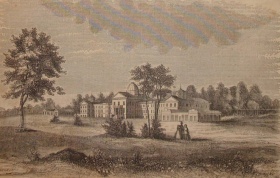Pre-1854 Plans
These represent the historic asylums built in the United States and the United Kingdom, prior to Dr. Kirkbride had composed his magnum opus book, and publicized his own theory regarding the organization of psychiatric hospital. Some of these buildings are based on earlier European ideas of asylum keeping, as well as regional ideas, and even individual reformer's ideologies. These early hospitals usually started with single, or few tightly clustered buildings, with no discernible design or layout for the growth of the site. Few to little of these survive to the present day, as many were replaced by allegedly more modern designs. The only common thread regarding their design was their location. For centuries it was perceived that Insanity (which is of Latin origin, 'sanus' meaning 'healthy') was as illness because of poor hygiene and/or moral failings. For this reason all asylums, up until the 20th century, were placed in the country-side where supposed hygienic practices could be encouraged to treat the cognitive and affective lapses of the patients.
The most infamous asylum for this period was Bethlem Royal Hospital in London, England, which was founded in the year 1247 as a Roman Catholic Priory dedicated to the care of "lunatics". Bethlem Royal Hospital, also known just as 'Bedlam' commonly, is still operational as a psychiatric facility. For many medical professionals in the western world, it set the standard for mental healthcare for the next few centuries. No discernible style is noted in these first psychiatric facilities, as many were not independent facilities, but associated with a religious order or monastery. However, following the Protestant Reformation, and the closure of many English monasteries by Henry VIII, care of the mentally ill was turned over to private madhouses, many of which were simply private residences. There were no state owned facilities for the care of the mentally ill prior to the opening for Trenton State Hospital in New Jersey, in 1848.



